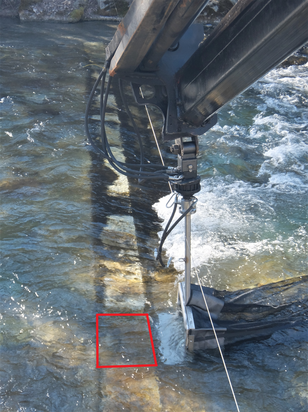Surrogate bedload transport measurements with the Swiss plate geophone system
Dieter Rickenmann
Suppléance Collaborateurs du projetTobias Nicollier
Dieter Rickenmann
2018 - 2022
Coopération FinancementPrediction of bedload transport is important for hazard assessment and in engineering applications such as the planning and implementation of flood protection measures. Continuous and reliable measurements of this process are difficult and challenging to obtain but important to advance the understanding of sediment transport in mountain streams. The Swiss plate geophone (SPG) system is a seismic method to measure bedload transport in water courses for which considerable experience has been accumulated over the last 15 years; it has been installed at more than 20 field sites, and direct bedload samples have been collected at many of these sites for calibration purposes. The main goal of this project is to further develop the SPG system by performing new sets of controlled experiments using an outdoor flume facility in Germany and to obtain further calibration measurements at Swiss SPG field sites.
Field Calibration ¶
Between 2018 and 2020, three bedload monitoring stations located along the Albula (GR), the Navisence (VS) and the Avançon de Nant (VD) streams, all equipped with impact plates, were calibrated. Two elements are necessary to calibrate a station, namely the seismic signal recorded by geophone sensors fixed under steel plates embedded in the bed, and the mass and size of the sediment particles that are being transported over them. Each year during the snow- and glacial-melt seasons, sediment samples have been collected with the help of a crane-mounted net sampler and a movable basket sampler fixed on a checkdam. In total more than 6500 kg of material has been collected for around 20 hours of total sampling time.
Calibration measurement with the crane-mounted net sampler at the Navisence monitoring station during Summer 2019.
Controlled Flume Experiments ¶
Each year after the field calibration campaign, controlled flume experiements were conducted at the Obernach flume facility. The goal of these tests is to identify the effect of site-specific parameters such as the bed slope, the roughness, the flow velocity or the grain-size composition on the recorded seismic signal. To do so, each field site has been reconstructed in a 25 m long and 1 m wide channel. Two types of experiments have been performed: i) single grain size experiments in order to investigate the instrument response for a given particle size, and ii) mixture experiments to reproduce the natural transport processes observed in the field.
Video recording of an experiment at the Obernach outdoor flume facility of TU Munich and the seismic signal recorded synchronously by the geophone sensors fixed under the steel plates.

